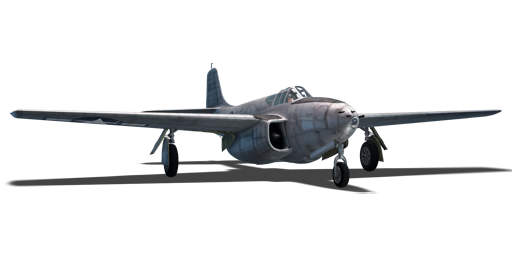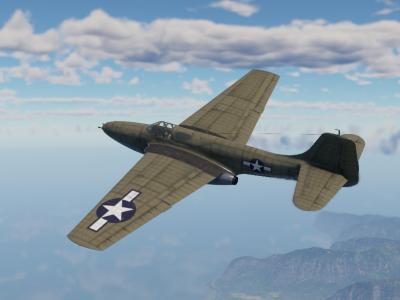


At the early stages of World War II in 1941, Major General Henry H. "Hap" Arnold was invited to attend a demonstration of the United Kingdom's Gloster E.28/39, the first British jet aircraft. Impressed with what he saw, he requested a copy of the blueprints to the Power Jets W.1 turbojet engine and received them along with a Whittle W.1X turbojet and drawings for the more powerful W.2B/23 engine. All of this was handed over to General Electric for them to produce a U.S. version of the engine. Next, Bell Aircraft Corporation was approached to build a fighter which would utilize this new jet. Accepting the challenge, Bell started by modifying a version of its P-63 Kingcobra propeller-powered fighter.
To accommodate the new type of engines, the P-59A underwent some significant modifications such as a higher placed wing (mid-fuselage compared to the P-63's low-wing setup), extended tail and fuselage and widened body to accept the turbojet engines. The new P-59A was plagued with many problems (many of which were attributed to early turbojets themselves), though, in the fighter was tested by pilot Chuck Yeager who was thoroughly dissatisfied with the speed of the aircraft, however, he noted that the flight characteristics of the aircraft were amazingly smooth.
Introduced during Update 1.89 "Imperial Navy" as a reward for the 2019 Operation H.E.A.T event, the P-59A finds itself in a unique position as a jet fighter sitting at rank IV, though just having turbojets compared to opponents at its battle rating sporting propellers will not give it the sole advantage. Several turbo-props will be able to keep up; however, the manoeuvrability of this aircraft is where it shines and when the pilot utilizes rudder control and combat flaps, the P-59A can surprisingly outmanoeuvre many aircraft including British Spitfires. The 37 mm autocannon and the three 12.7 mm machine guns are sufficient enough to punch large holes through enemy aircraft or dismantle them piece-by-piece. Without any suspended ordnance, the P-59A will strictly be a fighter/bomber interceptor unless there is a corner of the map where the Airacomet can ground attack without the threat of ambush by enemy fighters as it will need to maintain its speed to be useful.
flaps
flaps
flaps
brake
| Belt | Belt filling | Armor penetration (mm) at a distance: | |||||
|---|---|---|---|---|---|---|---|
| 10 m | 100 m | 500 m | 1000 m | 1500 m | 2000 m | ||
| HEFI-T/AP-T | 37 | 34 | 25 | 18 | 12 | 9 | |
| HEFI-T/HEFI-T/AP-T | 37 | 34 | 25 | 18 | 12 | 9 | |
| AP-T | 37 | 34 | 25 | 18 | 12 | 9 | |
| Belt | Belt filling | Armor penetration (mm) at a distance: | |||||
|---|---|---|---|---|---|---|---|
| 10 m | 100 m | 500 m | 1000 m | 1500 m | 2000 m | ||
| API-T/AP/AP/I | 30 | 27 | 20 | 13 | 9 | 6 | |
| AP-I/AP-I/API-T/I/I | 28 | 26 | 18 | 11 | 7 | 4 | |
| API-T/I/AP/AP/AP-I/AP-I | 30 | 27 | 20 | 13 | 9 | 6 | |
| API-T | 28 | 26 | 18 | 11 | 7 | 4 | |
| AP-I/I/AP-I/I | 28 | 26 | 18 | 11 | 7 | 4 | |







 2 x (95 / 210 / 530) %
2 x (95 / 210 / 530) % 
 2 x 166 %
2 x 166 % 

Flight performance | |
|---|---|
Survivability |
|---|
Weaponry |
|---|
